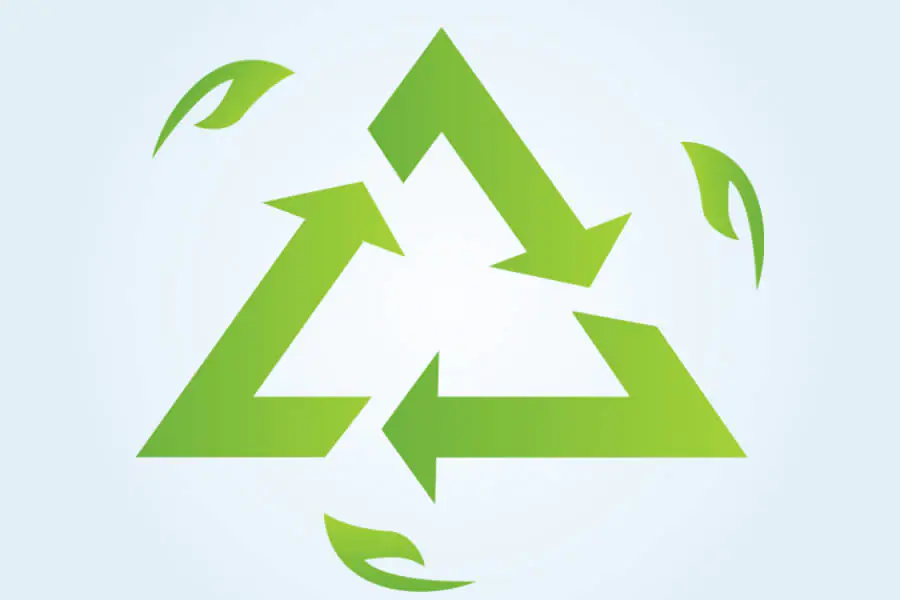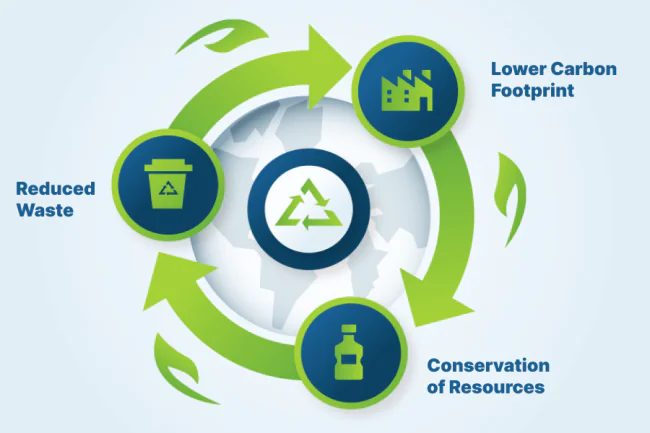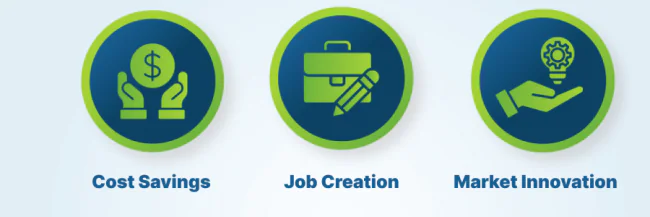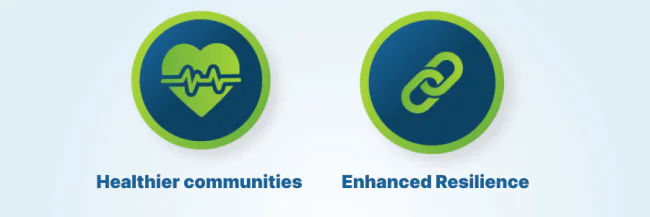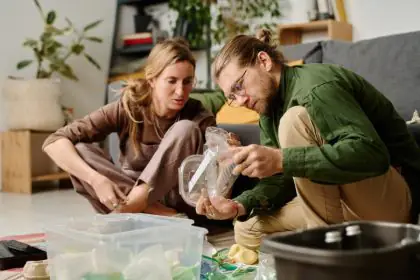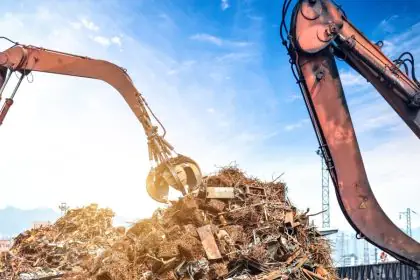What is Circular Economy?
In simple terms, a circular economy is an economic system aimed at minimizing waste and making the most of resources.
Unlike the traditional linear economy, which follows a ‘take, make, dispose‘ model, it emphasizes a loop where products, materials, and resources are reused, refurbished, and recycled.
It’s like giving everything a second, third, or even fourth life! This approach not only helps the planet but also supports sustainable business growth.
The circular economy is built on four main principles that guide sustainable practices:
Reduce: This principle focuses on minimizing waste and resource use right from the design phase. It’s about making products that last longer, use fewer materials, and are designed for disassembly and repair.
Reuse: Rather than discarding products after their initial use, the reuse principle encourages giving items a second life. This could mean reusing an item as is or repurposing it for a different function. Think about all those upcycled furniture pieces or second-hand clothes!
Recycle: When products reach the end of their useful life, recycling comes into play. Recycling ensures that materials are processed and turned into new products, reducing the need for virgin resources and lowering environmental impact.
Regenerate: This principle goes beyond simply avoiding harm—it actively seeks to improve and regenerate natural systems. It’s about enhancing biodiversity, restoring ecosystems, and using renewable resources.
Benefits of Circular Economy
Implementing its principles offers a wide range of benefits, not just for the environment, but also for economies and societies.
Environmental Benefits
- Reduced Waste: By keeping products and materials in use longer, we drastically cut down on the waste that ends up in landfills or pollutes our oceans. Imagine a world where every product is reused or recycled—that’s the goal!
- Lower Carbon Footprint: Circular practices reduce the need for new raw materials, which in turn lowers greenhouse gas emissions from mining, production, and transportation. It’s a big win for the fight against climate change.
- Conservation of Resources: The circular economy reduces the demand for new resources, such as metals, water, and fossil fuels. This helps preserve natural habitats and biodiversity.
Economic Benefits
- Cost Savings: For businesses, a circular model can mean significant savings on material costs. Companies can use fewer resources, cut waste management expenses, and create new revenue streams by selling refurbished or recycled products.
- Job Creation: The shift to a circular economy is expected to create millions of new jobs, from recycling and repair services to innovative product design. It’s an opportunity for green job growth that benefits communities.
- Market Innovation: The circular economy encourages innovation in product design, business models, and services. Companies that embrace this model can differentiate themselves and capture new market opportunities.
Social Benefits
- Healthier Communities: Reducing pollution and waste can lead to cleaner air, water, and soil, promoting healthier living conditions for people.
- Enhanced Resilience: By creating systems that rely less on finite resources, communities and businesses can become more resilient to supply chain disruptions.
Circular Economy Challenges and Opportunities
While the benefits are clear, implementing a circular economy is not without its challenges. However, these challenges also present opportunities for growth and innovation.
Challenges in Implementing Circular Economy
- Changing Mindsets: Shifting from a linear to a circular mindset requires significant changes in consumer behavior, business practices, and policy frameworks.
- Infrastructure Needs: Effective recycling and reusing infrastructure must be in place to support circular practices. In many places, current systems are inadequate.
- Regulatory Barriers: Existing regulations often favor linear economic models. Updating these frameworks to support circular practices is a critical step.
Opportunities for Innovation and Growth
- Technological Advancements: Technologies like AI, blockchain, and IoT can play a pivotal role in tracking resources, optimizing processes, and reducing waste.
- New Business Models: The circular economy encourages businesses to explore models like product-as-a-service, where companies lease products instead of selling them, ensuring they remain in the loop.
Real-World Examples
The circular economy is already being embraced by various industries around the world, including in Spain.
Sustainable Practices in the Fashion Industry
Brands like Ecoalf, a Spanish company, are leading the way by creating clothing and accessories from recycled materials, such as plastic bottles and fishing nets. Their motto? “There is no planet B.”
Technological Solutions in the Electronics Industry
Companies like Fairphone are designing smartphones that are easy to repair and upgrade, extending their lifespan and reducing electronic waste.
Food Industry Initiatives for Sustainable Packaging
Innovations in biodegradable packaging, edible coatings, and waste-to-energy technologies are transforming the food industry’s approach to sustainability.
Government Initiatives and Policy Frameworks
Government policies play a crucial role in promoting circular economy practices.
EU Circular Economy Action Plan
The European Union’s Circular Economy Action Plan is a comprehensive strategy that aims to make sustainable products the norm, reduce waste, and ensure the EU is climate-neutral by 2050.
National Strategies for Circular Economy
Spain has been proactive with its own Circular Economy Strategy, which sets ambitious targets for waste reduction and resource efficiency by 2030. This includes measures to support eco-design, improve waste management, and promote sustainable consumption.
Future Perspectives on Circular Economy
Looking ahead, the circular economy will continue to evolve, driven by technology and collaboration.
Role of Technology and Innovation
Technologies like 3D printing, bioplastics, and renewable energy will further enhance circular practices, making them more efficient and accessible.
Importance of Stakeholder Collaboration
The success of the circular economy depends on collaboration between governments, businesses, and consumers. By working together, we can accelerate the transition to a more sustainable future.
Conclusion
The circular economy is more than just a buzzword—it’s a necessary shift towards a sustainable and resilient future.
By embracing the principles of reduce, reuse, recycle, and regenerate, we can create a system that benefits the planet, our economies, and our societies.
Whether you’re an individual making small changes in your daily life, a business innovating new products, or a policymaker shaping the future, everyone has a role to play in the circular economy.
FAQs
What are the benefits of the circular economy?
The circular economy reduces waste, conserves resources, lowers carbon emissions, and creates economic opportunities, such as job growth and cost savings.
What is a circular economy in simple words?
A circular economy is an approach where resources are used, reused, and recycled to minimize waste and environmental impact, creating a closed-loop system.
What are the four main concepts of the circular economy?
The four main concepts are reduce (minimizing waste), reuse (repurposing items), recycle (processing materials into new products), and regenerate (enhancing natural systems).

